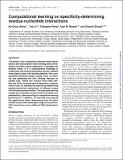Computational learning on specificity-determining residue-nucleotide interactions
Author(s)
Wong, Ka-Chun; Li, Yue; Peng, Chengbin; Moses, Alan M.; Zhang, Zhaolei
DownloadWong-2015-Computational learni.pdf (4.207Mb)
OPEN_ACCESS_POLICY
Open Access Policy
Creative Commons Attribution-Noncommercial-Share Alike
Terms of use
Metadata
Show full item recordAbstract
The protein–DNA interactions between transcription factors and transcription factor binding sites are essential activities in gene regulation. To decipher the binding codes, it is a long-standing challenge to understand the binding mechanism across different transcription factor DNA binding families. Past computational learning studies usually focus on learning and predicting the DNA binding residues on protein side. Taking into account both sides (protein and DNA), we propose and describe a computational study for learning the specificity-determining residue-nucleotide interactions of different known DNA-binding domain families. The proposed learning models are compared to state-of-the-art models comprehensively, demonstrating its competitive learning performance. In addition, we describe and propose two applications which demonstrate how the learnt models can provide meaningful insights into protein–DNA interactions across different DNA binding families.
Date issued
2015-11Department
Massachusetts Institute of Technology. Computer Science and Artificial Intelligence LaboratoryJournal
Nucleic Acids Research
Publisher
Oxford University Press
Citation
Wong, Ka-Chun, Yue Li, Chengbin Peng, Alan M. Moses, and Zhaolei Zhang. “Computational Learning on Specificity-Determining Residue-Nucleotide Interactions.” Nucleic Acids Research (November 2, 2015): gkv1134.
Version: Final published version
ISSN
0305-1048
1362-4962